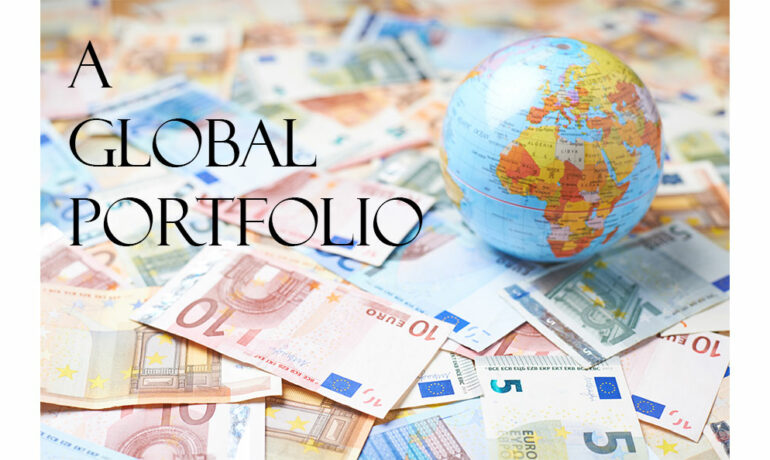The S&P 500 Index returned 11.03% and the S&P Global Broad Market Index returned 5.84% in the quarter ended December 31, 2021.1
In our last letter, we wrote about some of the larger positions we’ve recently acquired for your portfolio. In this letter, we’re focusing on some smaller new investments that we think further diversify and globalize your portfolio. They are HDFC Bank, Alibaba, Tencent, and PayPal, and, in the remainder of the letter, we’ll discuss why we find the long-term prospects of these businesses to be so attractive.
HDFC Bank
HDFC Bank is the largest private sector bank in India with an 8.5% market share of deposits and a 9.6% market share of loans.2 Large banks tend to be good businesses because, through deposits, they are able to borrow money at a low rate relative to their competitors, primarily non-bank corporations and smaller banks. This funding cost advantage occurs because 1) the government guarantees bank deposits (in the case of India, up to 500,000 rupees—approximately $6,700 at current exchange rates—per account);3 2) the industry is highly regulated, creating barriers to entry; 3) among banks, many customers value the liquidity, security, and convenience that the large banks provide over the higher interest rate they could earn if they deposited their money elsewhere; and 4) switching costs prevent most customers from constantly shopping and bouncing around for the highest deposit rates among the large banks. While this funding advantage is the most critical, it’s not the only advantage the large banks possess. The large banks also possess superior geographic and product diversification that reduces the risk of their loan portfolio relative to more specialized lenders as well as economies-of-scale cost advantages in areas such as technology, cybersecurity, regulation, and marketing. And, in India, the large private sector banks have an even greater advantage. Unlike in the United States, where all banks are private, only 40% of the banks in India are private and only 36% are private and domestic (with the remaining 4% being foreign banks). Because the public sector banks are older and owned by the government (at least 50% of shares outstanding)4 and, as a result, have less customer-focused and return-on-capital-driven cultures, they tend to be share-donors to the private sector banks over time. In fact, since 2015, public sector banks have ceded roughly 15 percentage points of market share to private sector banks.5
HDFC Bank, in particular, also benefits from a belief network effect. Like J.P. Morgan in the United States, HDFC Bank, as the leading private sector bank in India, is the preferred partner for many businesses, executives, and individuals because the brand is associated with excellence, wealth, safety, technological prowess, and customer service. However, unlike J.P. Morgan, HDFC Bank is not only the most valuable banking brand in its country—it is also the most valuable brand of any kind in its country.6
As a result of its many advantages, we believe HDFC Bank will continue taking market share and earning industry-leading returns for a long time to come.7 Also, a bet on a bank is, in many ways, a levered bet on a country. And, in our view, there are few countries with a brighter future than India. With its democratic political system, strong rule-of-law, soon-to-be-largest-in-the-world population (1.4 billion and growing), 8 low GDP per capita ($1,900 versus the U.S. at $63,544),9 and uniquely favorable demographics (where, in contrast to China, Europe, Japan, and the U.S., the working age population is and will likely remain larger than the non-working population for the next 35 years),10 we think India is likely to grow its GDP for many decades at much faster rates than the world as a whole, and we think HDFC Bank is the business best positioned to profitably ride this powerful growth wave.
Tencent
Tencent owns two of the largest social networks in China: Weixin (WeChat is the international version) and QQ. Weixin, with 1.2 billion users (out of a total China population of 1.4 billion), is far and away the most important social network in China with consumers using its “everything app” for instant messaging, social media, mobile payments, shopping, video gaming, and more. It benefits from two-sided network effects that connect users with advertisers, stores, gaming companies, influencers, and a whole host of other parties that want access to Weixin’s massive user base. It also benefits from an app-store-like network effect that connects users with third parties who have created mini-apps11 for use within the Weixin app. QQ, with 600 million monthly active users,12 is in many ways the predecessor to Weixin, providing many similar functions but in a desktop-centric format.13 Tencent has used its prodigious cash flows from its social networks to fund an extremely successful venture capital portfolio that includes stakes in some of the most exciting businesses in the world including Meituan (the largest food delivery service in China), Sea Ltd (the largest gaming and e-commerce platform in Southeast Asia), JD.com (the second-largest e-commerce company in China), and many more. Part of the reason for Tencent’s high hit rate is because the company can exchange access to and information on its billion-plus user base for ownership stakes in young and promising apps, which is very reminiscent of the early cable pioneer John Malone who exchanged his cable company’s access to millions of households for early stakes in Discovery, QVC, BET, CNN, and numerous other channels. Lastly, Tencent is the third largest cloud services provider in China behind Alibaba and Huawei. 14 As a result of Tencent’s unrivaled network of Chinese users, we believe the company is in a great position to benefit from the growth in China’s GDP and the secular trend toward digital advertising, e-commerce, payments, and cloud computing, all of which are underpenetrated. Moreover, because network value rises exponentially as new participants join a network, we believe Tencent is likely to maintain or even increase its pricing power over time.
Alibaba
Alibaba is far and away the largest e-commerce company in China with an estimated 47% market share (the next largest is JD with 17% share).15 Additionally, Alibaba Cloud is the largest cloud service provider in China with 38% market share (the next largest is Huawei with 17% share).16 Both of these businesses are dominant networks with high switching costs in industries that we believe can continue to grow much faster than GDP for many years to come.
In the case of e-commerce, Alibaba benefits from two-sided network effects as a result of its unrivaled marketplace connecting consumers with both third-party sellers and advertisers. Furthermore, Alibaba’s platform connects e-commerce merchants with logistics providers, enabling increasingly efficient delivery as Alibaba’s e-commerce and logistics platforms increase in size. Additionally, e-commerce still only has 47.2% penetration of Chinese retail sales,17 offering the opportunity for the company to grow faster than GDP for many years to come. Lastly, retail sales in China as a whole are growing quite fast, with retail sales expected to grow at a compound annual growth rate of over 12% for the next three years.18
In the case of cloud services, which allow companies to outsource their key information technology needs such as computing, storage, networking, database, and analytics, Alibaba Cloud benefits from physical network effects as a result of its unrivaled Chinese network of data centers including over 56 availability zones across 13 regions in China, 15 availability zones across 7 regions in the Asia Pacific region, and 9 availability zones across 5 regions in the rest of the world.19 These network effects are so strong and the investment required to build the network is so massive that Google Cloud Services, the third biggest cloud services provider in the world with annualized revenues as of Q2 2021 of $18.4 billion, is still experiencing annualized operating losses of $2.4 billion.20 Similarly, Alibaba Cloud had almost a billion dollar operating loss in 2020 despite $5.7 billion in cloud revenue. However, at scale, these businesses are extremely profitable. Amazon Web Services (also known as AWS) shows what’s possible. During 2020, the global cloud services leader earned $13.5 billion of operating income on $45 billion of revenue.21 As the clear cloud services leader in China, we believe Alibaba could one day achieve similarly high levels of profitability. Alibaba Cloud also benefits from protocol network effects. Because of the complexity of cloud environments such as Alibaba Cloud, it can take years for a software engineer to become an expert in just one of them. When combined with the fact that the market for software engineers is both liquid (i.e. many software engineers change jobs frequently) and global, it’s no surprise that the Chinese cloud services market has coalesced around only a few industry standards or “protocols.” Furthermore, Alibaba Cloud benefits from an app-store-like network that connects Alibaba Cloud customers with third party software providers who have created applications for use on Alibaba Cloud. As if three types of network effects weren’t enough, Alibaba Cloud also possesses extremely high switching costs since it is incredibly costly (both in time and money) and risky to migrate core IT infrastructure from one cloud service provider to another. Lastly, Alibaba Cloud operates in an industry with attractive long-term growth tailwinds. In 2019, China spent only 1.4% of its GDP on enterprise IT, much lower than the U.S.’s comparable figure of 4.7%. Furthermore, of this total, China spent just 2.7% on cloud services.22 However, as more and more Chinese businesses modernize, these percentages are rising rapidly. As a result, we believe Alibaba Cloud is likely to grow significantly faster than GDP for many years to come.
PayPal
PayPal is the dominant online payment processing software technology with 50% worldwide market share. The next largest competitors are Stripe with 15% market share and Shopify Pay Installments with 9% market share.23 In other words, PayPal has created the leading online two-sided network connecting merchants and consumers all over the globe. In fact, as of September 30, 2021, PayPal’s platform has scaled to 416 million active accounts, including 33 million active merchant accounts. This ability to see both sides of a transaction more clearly than competitors has enabled PayPal to increase conversion rates for online retailers while simultaneously more quickly and accurately assessing fraud risks. When combined with the unique data and measurement advantages that the internet provides, this two-way view also enables PayPal to innovate more rapidly than many other payments players since it can quickly assess the merchant and consumer impact of new financial products and services that it adds to its platform. As a result, PayPal is one of the leading contenders to develop a super-app that integrates “direct deposit, bill pay, a digital wallet, peer-to-peer payments, shopping tools, crypto capabilities, and more.”24
Whether or not PayPal succeeds in creating a super-app, we think its future is bright. Its virtually unrivaled online merchant and consumer network puts PayPal in prime position to benefit from the dual secular trends of e-commerce, which still accounts for less than 20% of global retail sales, 25 and financial digitization. Moreover, because network value rises exponentially as 1) new participants join a network and 2) each node (i.e. user) of the network gets more productive (in this case, through PayPal’s ever-expanding product and service offerings), we believe PayPal is both difficult to disrupt and likely to maintain or even increase its pricing power over time. Finally, not only does PayPal benefit from network economics but it also benefits from essentially no marginal costs as a result of its digital business model. In other words, the company can process higher per user sales volumes or add new users with little to no human intervention and little need for new physical capital, which means that incremental revenue translates almost entirely into incremental profit. These three factors (e-commerce and financial digitization growth, the economics of networks, and low variable costs) have led to high and increasing returns on capital for PayPal. They also justify, in our view, a higher valuation multiple for PayPal than for most other businesses.
Concluding Thoughts
We hope you’ve found these descriptions of our new investments to be informative and compelling. If you would like to refer back to them at some point in the future (or to any of the other investment rationales we’ve written), they will be posted on our Global Champions page at https://ycginvestments.com/commentary/.
As always, if you have any questions about your accounts or what we’ve written in this letter, please reach out to us. Finally, thank you so much for your trust, know we’re invested right alongside you, and we hope your year has gotten off to a great start!
Sincerely,
The YCG Team
Disclaimer: The specific securities identified and discussed should not be considered a recommendation to purchase or sell any particular security nor were they selected based on profitability. Rather, this commentary is presented solely for the purpose of illustrating YCG’s investment approach. These commentaries contain our views and opinions at the time such commentaries were written and are subject to change thereafter. The securities discussed do not necessarily reflect current recommendations nor do they represent an account’s entire portfolio and, in the aggregate, may represent only a small percentage of an account’s portfolio holdings. A complete list of all securities recommended for the immediately preceding year is available upon request. These commentaries may include “forward looking statements” which may or may not be accurate in the long-term. It should not be assumed that any of the securities transactions or holdings discussed were or will prove to be profitable. S&P stands for Standard & Poor’s. All S&P data is provided “as is.” In no event, shall S&P, its affiliates or any S&P data provider have any liability of any kind in connection with the S&P data. MSCI stands for Morgan Stanley Capital International. All MSCI data is provided “as is.” In no event, shall MSCI, its affiliates or any MSCI data provider have any liability of any kind in connection with the MSCI data. Past performance is no guarantee of future results.
1 For information on the performance of our separate account composite strategies, please visit www.ycginvestments.com/performance. For information about your specific account performance, please contact us at (512) 505-2347 or email [email protected]. All returns are in USD unless otherwise stated.
2 See https://blog.investyadnya.in/indias-top-5-banks-by-market-share/.
3 See https://indianexpress.com/article/explained/explained-what-is-deposit-insurance-law-changes-benefit-account-holders-7428921/.
4 See https://en.wikipedia.org/wiki/Public_sector_banks_in_India.
5 See https://theprint.in/economy/in-just-5-years-private-banks-have-narrowed-public-sectors-huge-lead-in-loans-deposits/550570/.
6 See https://www.businesstoday.in/industry/banks/story/most-valuation-brands-hdfc-bank-retains-top-position-reliance-retail-273465-2020-09-19 and https://thebrandhopper.com/2020/11/09/brand-hdfc-bank-indias-most-valuable-brand/.
7 See https://www.quora.com/Why-is-HDFC-Bank-better-compared-to-other-banks and https://www.hdfcbank.com/personal/about-us/news-room/press-release/2021/q3/hdfc-bank-named-best-bank-in-india-by-financeasia?__cf_chl_jschl_tk__=3gGjqXR2KVEh.L3VYWDS5X6RQQPwZm5oPKNARcyLAo0-1638820377-0-gaNycGzNCL0.
8 See https://www.business-standard.com/article/current-affairs/india-may-overtake-china-as-most-populous-country-even-before-2027-report-121051201219_1.html.
9 See https://data.worldbank.org/indicator/NY.GDP.PCAP.CD?locations=IN.
10 See https://economictimes.indiatimes.com/news/economy/indicators/india-enters-37-year-period-of-demographic-dividend/articleshow/70324782.cms?from=mdr.
11 See https://blog.hubspot.com/marketing/mini-apps.
12] See https://www.statista.com/statistics/227352/number-of-active-tencent-im-user-accounts-in-china/.
13 See https://www.clickz.com/qq-the-biggest-digital-platform-youve-never-heard-of/113476/.
14 See https://www.statista.com/statistics/1129265/china-cloud-infrastructure-service-market-share-by-company/.
15 See https://www.emarketer.com/content/china-ecommerce-forecast-2021.
16 See https://www.statista.com/statistics/1129265/china-cloud-infrastructure-service-market-share-by-company/.
17 See https://www.emarketer.com/content/china-ecommerce-forecast-2021.
18 See https://www.businessoffashion.com/news/china/chinas-e-commerce-market-to-hit-3-trillion-in-annual-sales-by-2024.
19 See https://www.alibabacloud.com/help/en/doc-detail/40654.htm and https://www.alibabacloud.com/global-locations.
20 See https://holori.com/2021-cloud-market-size-and-aws-azure-gcp-market-share/.
21 See https://www.sec.gov/ix?doc=/Archives/edgar/data/1018724/000101872421000004/amzn-20201231.htm.
22 See https://seekingalpha.com/article/4346511-chinas-burgeoning-cloud-computing-market-is-tremendous-opportunity.
23 See https://www.statista.com/statistics/895236/australia-market-share-online-payment-platforms/.
24 See https://techcrunch.com/2021/09/21/paypal-launches-its-super-app-combining-payments-savings-bill-pay-crypto-shopping-and-more/.
25 See https://www.emarketer.com/content/global-ecommerce-forecast-2021.




